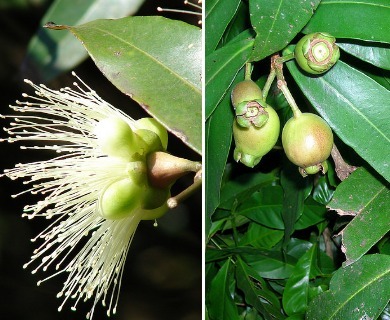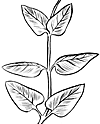Rose-apple
Syzygium jambos
Eucalyptus-Like family (Myrtaceae)
Post-Cook introduction
Naturalized tree with handsome foliage and edible distinguished by paired shiny dark green lance-shaped leaves, few large yellowish white four-petaled flowers 3–4 inches (7.5–1 0 ) across numerous threadlike and pale yellowish or pinkish tinged, rounded or elliptical 1 1⁄4–1 1⁄2 inches (3–4 ) long, with odor and flavor like rose perfume.

©2007 Forest And Kim Starr
Leaves hairless, with short leaf-stalks of 3⁄16–3⁄8 inch (5–10 ). Blades lance-shaped, 3 1⁄2–8 inches (9–20 ) long and 5⁄8–1 3⁄4 inches (1.5–4.5 ) broad, long-pointed at short-pointed at base, not on edges, leathery, shiny dark green on upper surface, dull green beneath, and with tiny -dots visible under a lens.
Flower clusters () commonly with 4–5 large flowers. Conical pinkish green tubular base () about 1⁄2 inch (13 ) high and wide, enclosing and bearing other parts; of four rounded broad 1⁄2 inch (13 ) long, on four rounded concave whitish petals about 5⁄8 inch (15 ) long, faintly tinged with green, coarsely -dotted; numerous threadlike and consisting of inferior two-celled and whitish slender 1 3⁄4 inches (4.5 ) long.
(berries) have four at pale yellow firm flesh with little juice. Seed single (sometimes two) rounded brown, 3⁄8 inch (1 ) diameter in large cavity.
Wood dull brown, hard, and heavy ( gr. 0.7). Not durable in soil and very susceptible to attack by drywood termites. Seldom used. Elsewhere, coarse baskets and barrel hoops have been made from young branches and poles from larger limbs.
Planted in the tropics for ornament, primarily for the showy flowers and handsome foliage. Sometimes used for windbreaks and shade. Occasionally, the insipid are made into jellies, preserves, and salads; it is a good honey plant. Elsewhere seeds and roots are utilized in home remedies. Trees reproduce naturally from seeds and sprout vigorously when cut. Shade beneath pure thickets generally kills out all vegetation.
Planted and sparsely naturalized through the Hawaiian Islands in moist areas such as pastures, waste places, and stream banks, from sea level to 1600 ft (488 ), rarely to 4000 ft (1,219 ) altitude. Usually found as an understory tree in mixture with guava (Psidium guajava). Classed as a weed.
Special areas
Waimea Arboretum, Tantalus
Range
Native of southeastern tropical Asia but now widely cultivated and naturalized through the tropics, including Puerto Rico and Virgin Islands. Planted also in Florida and southern California. Introduced into Hawaii about 1825, apparently for the edible though insipid aromatic
Other common name
pomarrosa (Puerto Rico, Spanish); youenwai (Pohnpei)
Botanical
Jambosa jambos (L.) Millsp., Eugenia jambos L.







